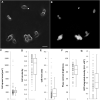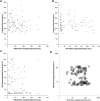Covariation of Pluripotency Markers and Biomechanical Properties in Mouse Embryonic Stem Cells
- PMID: 35652102
- PMCID: PMC9149596
- DOI: 10.3389/fcell.2022.858884
Covariation of Pluripotency Markers and Biomechanical Properties in Mouse Embryonic Stem Cells
Abstract
Pluripotent cells are subject to much interest as a source of differentiated cellular material for research models, regenerative medical therapies and novel applications such as lab-cultured meat. Greater understanding of the pluripotent state and control over its differentiation is therefore desirable. The role of biomechanical properties in directing cell fate and cell behavior has been increasingly well described in recent years. However, many of the mechanisms which control cell morphology and mechanical properties in somatic cells are absent from pluripotent cells. We leveraged naturally occurring variation in biomechanical properties and expression of pluripotency genes in murine ESCs to investigate the relationship between these parameters. We observed considerable variation in a Rex1-GFP expression reporter line and found that this variation showed no apparent correlation to cell spreading morphology as determined by circularity, Feret ratio, phase contrast brightness or cell spread area, either on a parameter-by-parameter basis, or when evaluated using a combined metric derived by principal component analysis from the four individual criteria. We further confirmed that cell volume does not co-vary with Rex1-GFP expression. Interestingly, we did find that a subpopulation of cells that were readily detached by gentle agitation collectively exhibited higher expression of Nanog, and reduced LmnA expression, suggesting that elevated pluripotency gene expression may correlate with reduced adhesion to the substrate. Furthermore, atomic force microscopy and quantitative fluorescent imaging revealed a connection between cell stiffness and Rex1-GFP reporter expression. Cells expressing high levels of Rex1-GFP are consistently of a relatively low stiffness, while cells with low levels of Rex1-GFP tend toward higher stiffness values. These observations indicate some interaction between pluripotency gene expression and biomechanical properties, but also support a strong role for other interactions between the cell culture regime and cellular biomechanical properties, occurring independently of the core transcriptional network that supports pluripotency.
Keywords: cell adhesion; cell morphology; cell stiffness; mouse embryonic stem cells; pluripotency marker.
Copyright © 2022 Brookes, Thorpe, Rigby Evans, Keeling and Lee.
Conflict of interest statement
The authors declare that the research was conducted in the absence of any commercial or financial relationships that could be construed as a potential conflict of interest.
Figures







Similar articles
-
Demarcation of stable subpopulations within the pluripotent hESC compartment.PLoS One. 2013;8(2):e57276. doi: 10.1371/journal.pone.0057276. Epub 2013 Feb 21. PLoS One. 2013. PMID: 23437358 Free PMC article.
-
A real-time pluripotency reporter for the long-term and real-time monitoring of pluripotency changes in induced pluripotent stem cells.Aging (Albany NY). 2022 May 15;14(10):4445-4458. doi: 10.18632/aging.204083. Epub 2022 May 15. Aging (Albany NY). 2022. PMID: 35575836 Free PMC article.
-
A Stem Cell Reporter for Investigating Pluripotency and Self-Renewal in the Rat.Stem Cell Reports. 2020 Jan 14;14(1):154-166. doi: 10.1016/j.stemcr.2019.12.001. Epub 2020 Jan 2. Stem Cell Reports. 2020. PMID: 31902707 Free PMC article.
-
Role of Oct4 in maintaining and regaining stem cell pluripotency.Stem Cell Res Ther. 2010 Dec 14;1(5):39. doi: 10.1186/scrt39. Stem Cell Res Ther. 2010. PMID: 21156086 Free PMC article. Review.
-
Dynamic Roles of Signaling Pathways in Maintaining Pluripotency of Mouse and Human Embryonic Stem Cells.Cell Reprogram. 2024 Apr;26(2):46-56. doi: 10.1089/cell.2024.0002. Cell Reprogram. 2024. PMID: 38635924 Review.
References
Grants and funding
LinkOut - more resources
Full Text Sources
Research Materials
Miscellaneous

